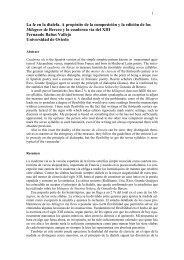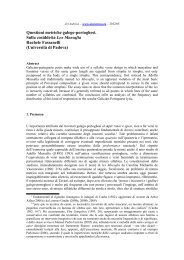Ars Metrica 2012/05 The Galician-Portuguese Lyrical Poetry in its ...
Ars Metrica 2012/05 The Galician-Portuguese Lyrical Poetry in its ...
Ars Metrica 2012/05 The Galician-Portuguese Lyrical Poetry in its ...
You also want an ePaper? Increase the reach of your titles
YUMPU automatically turns print PDFs into web optimized ePapers that Google loves.
<strong>Ars</strong> <strong>Metrica</strong> <strong>2012</strong>/<strong>05</strong><br />
<strong>The</strong> <strong>Galician</strong>-<strong>Portuguese</strong> <strong>Lyrical</strong> <strong>Poetry</strong> <strong>in</strong> <strong>its</strong> Hispanic Context II.<br />
Abstracts<br />
1<br />
Ripetizione, parallelismo e leixaprén: il testo e la musica<br />
Ella Bernadette Nagy<br />
(Università degli Studi di Padova)<br />
Abstract<br />
This essay exam<strong>in</strong>es the relationship among text, meter, and music <strong>in</strong> the <strong>Galician</strong>-<strong>Portuguese</strong><br />
cantigas, us<strong>in</strong>g compositions that make explicit reference to dance forms as a po<strong>in</strong>t of departure.<br />
Several f<strong>in</strong>d<strong>in</strong>gs po<strong>in</strong>t to the existence of the bailada genre <strong>in</strong> the <strong>Galician</strong>-<strong>Portuguese</strong> region,<br />
though they are <strong>in</strong>sufficient for def<strong>in</strong><strong>in</strong>g <strong>its</strong> precise characteristics. However, the texts under study<br />
have certa<strong>in</strong> formal tra<strong>its</strong> <strong>in</strong> common, such as a basic aaB structure, the presence of a refrán and<br />
their frequent use of repetition. <strong>The</strong> second part of this essay is dedicated to the role of music <strong>in</strong> the<br />
development of the repetitive techniques characteristic of the <strong>Galician</strong>-<strong>Portuguese</strong> school<br />
(parallelism and leixaprén), as well as to compositions built on meters analogous to the Occitan<br />
balada or the French rondel. <strong>The</strong> study concludes with an exam<strong>in</strong>ation of the relationship between<br />
rhythmic and melodic structure <strong>in</strong> the Cantigas de Santa Maria, which recall the cantigas de amigo<br />
from a formal po<strong>in</strong>t of view and share aff<strong>in</strong>ities with “choreographic” genres of contemporary<br />
romance-language song forms.<br />
2<br />
Uso y función del verso alejandr<strong>in</strong>o en las Cantigas de Santa María<br />
Elena González-Blanco García – Ma. Gimena del Rio Riande<br />
(Universidad Nacional de Educación a Distancia)<br />
Abstract<br />
In this paper we study the use and function of the Alexandr<strong>in</strong>e, one of the most important verses <strong>in</strong><br />
medieval Castilian poetry and <strong>in</strong> Alfonso X’s Cantigas de Santa María. Even though the K<strong>in</strong>g’s<br />
religious collection has been deeply analyzed <strong>in</strong> many ways, there are no studies about the use and<br />
functions of the Alexandr<strong>in</strong>e verse <strong>in</strong> the narrative cantigas. We will show how this l<strong>in</strong>e serves as a<br />
pattern to model narrative content, not only <strong>in</strong> poems with a well-known source, but also <strong>in</strong> other<br />
texts <strong>in</strong> which the source is unknown or tied to popular or oral tradition.<br />
3<br />
Questioni metriche galego-portoghesi. Sulla cosiddetta Lex Mussafia<br />
Rachele Fassanelli<br />
(Università di Padova)<br />
Abstract<br />
<strong>Galician</strong>-<strong>Portuguese</strong> poets make wide use of a syllabic verse design <strong>in</strong> which mascul<strong>in</strong>e and<br />
fem<strong>in</strong><strong>in</strong>e verses of the same gross length are equated from strophe to strophe, not only juxtaposed <strong>in</strong><br />
the body of a s<strong>in</strong>gle strophe. This correspondence, first noticed by Adolfo Mussafia and<br />
traditionally named lex Mussafia, is an apparent violation of the most basic pr<strong>in</strong>ciple of Provençal<br />
composition: a given verse should correspond to verses <strong>in</strong> the same position <strong>in</strong> all other strophes.<br />
<strong>The</strong> essay aims to show that the common <strong>in</strong>terpretation of the lex is <strong>in</strong>exactly conceived, because<br />
it’s generally referred to all poems <strong>in</strong> which l<strong>in</strong>es of the same number of syllables are comb<strong>in</strong>ed.<br />
<strong>The</strong> conclusions offer an analysis of the frequency and distribution of this k<strong>in</strong>d of responsion <strong>in</strong> the<br />
secular <strong>Galician</strong>-<strong>Portuguese</strong> lyric.
4<br />
El tetrástico y las series monorrimas<br />
en la poesía occitano-catalana medieval<br />
Joan Mahiques Climent<br />
(Institut National d’Histoire de l’Art)<br />
Abstract<br />
<strong>The</strong> analysis of a large corpus of medieval Catalan poetry allows us to b<strong>in</strong>d the use of tetrastich and<br />
some monorhyme series to the Occitan-Catalan post-troubadour poetry of thirteenth and fourteenth<br />
centuries. Catalan poetry of fifteenth and sixteenth centuries written <strong>in</strong> monorhythmic l<strong>in</strong>es is<br />
smaller <strong>in</strong> proportion to that of previous centuries. Most of the works studied here are religious and<br />
anonymous. <strong>The</strong> manuscripts of these compositions are characterized by metrical irregularity,<br />
although some poems based <strong>in</strong> pre-exist<strong>in</strong>g melodies, such as Veni, creator Spiritus, which stands<br />
out because of <strong>its</strong> clear tendency to strophic regularity. In fact, some poems have musical notation<br />
or rubrics that <strong>in</strong>dicate the tone <strong>in</strong> which they might be sung. F<strong>in</strong>ally, it is emphasized the use of<br />
octosyllabic and decasyllabic verse with caesura; and anaphora and <strong>in</strong>ternal rhyme as some of the<br />
most common rhetorical devices, specially <strong>in</strong> long-l<strong>in</strong>e stanzas.<br />
5<br />
La métrica cancioneril en la época de los Reyes Católicos:<br />
la poesía de Pedro de Cartagena<br />
Ana M. Rodado Ruiz<br />
(Universidad de Castilla-La Mancha)<br />
Abstract<br />
This article analyzes the poetry of Pedro de Cartagena as a representative work about the uses and<br />
metric artifices of the court poetry <strong>in</strong> the age of the Catholic Monarchs. After a long way from the<br />
most ancient song-books as Baena’s compilation (PN1) or the Cancionero de Palacio (SA7), <strong>in</strong><br />
which we can still f<strong>in</strong>d traces of Occitan and <strong>Galician</strong>-<strong>Portuguese</strong> traditions, the turn-of-the-century<br />
song-books represent a moment of fullness <strong>in</strong> the evolution of the metric genres. Cartagena’s work<br />
offers a wide and varied sample of both the metric preferences and the high degree of<br />
experimentation reached by the poetry dur<strong>in</strong>g this fruitful literary period.<br />
Varia<br />
6<br />
<strong>The</strong> <strong>Metrica</strong>l Structure of Kashmiri Vanɨvun<br />
Sadaf MUNSHI<br />
(University of North Texas)<br />
Abstract<br />
Poetics, as Roman Jakobson states <strong>in</strong> his remarks about poetry <strong>in</strong> relation to l<strong>in</strong>guistics, primarily<br />
deals with the question, “What makes a verbal message a work of art?” In oral traditions of poetry,<br />
various l<strong>in</strong>guistic entities are employed by poets <strong>in</strong> the formation of metrical constra<strong>in</strong>ts without<br />
mak<strong>in</strong>g them obvious as conscious sets of rules (See Kiparsky 1972 [1988]: 96). Many different<br />
clues are employed by poets <strong>in</strong> traditional societies to help understand the nature of these l<strong>in</strong>guistic<br />
entities. <strong>The</strong> ma<strong>in</strong> objectives of this paper are: (1) to describe the metrical structure of Vanɨvun – a<br />
popular genre of Kashmiri folklore, and (2) to analyze the metrical constra<strong>in</strong>ts/peculiarities<br />
characteriz<strong>in</strong>g the elegant structure of this poetic genre. As a poetic genre, Vanɨvun poses a<br />
challenge to most available models of poetic composition where PROMINENCE is treated <strong>in</strong> terms of<br />
metrical asymmetry between Strong and Weak positions. <strong>The</strong> metrical structure of Vanɨvun presents
a three-way dist<strong>in</strong>ction <strong>in</strong> terms of prom<strong>in</strong>ence where beats can be classified as: Strong, Weak or<br />
Intermediate. <strong>The</strong> dist<strong>in</strong>ction is based on <strong>in</strong>terplay of quantitative, positional and rhythmic factors<br />
characteristic of Kashmiri phonological stress (See Munshi & Crowhurst 2011). Under this view,<br />
each metrical division (“measure”) <strong>in</strong> a l<strong>in</strong>e typically behaves like a trisyllabic prosodic word <strong>in</strong><br />
which a primary stress falls on the first and a secondary (“<strong>in</strong>termediate”) stress on the third (f<strong>in</strong>al)<br />
syllable. <strong>The</strong> desired output is achieved through various repair mechanisms <strong>in</strong> the form of quantity<strong>in</strong>creas<strong>in</strong>g<br />
and/or decreas<strong>in</strong>g strategies apply<strong>in</strong>g to the <strong>in</strong>put.<br />
Keywords: accentual verse, lexical selection genres, metrics, metricality, morphophonemics,<br />
quantitative verse, sprung rhythm, stress, syllabic verse, versification.






